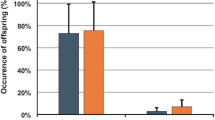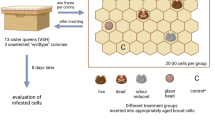Abstract
The removal of Varroa destructor was assessed in Russian honey bee (RHB) colonies with known levels of Varroa Sensitive Hygienic (VSH) and brood removal activities. The expression of grooming behaviour using individual bees was also measured using three groups of RHB displaying different VSH levels: low hygiene (RHB-LH, < 35% VSH), medium hygiene (RHB-MH, 35–70%) and high hygiene (RHB-HH, > 70%). Italian colonies (5.43–71.62% VSH) served as control. Our results demonstrated, for the first time, significant relationships between two hygienic responses (VSH activity measured as percent change in infestation and the actual brood removal of Varroa-infested donor comb) and two measurements of mite fall (trapped old mites/trapped mites or O/T and trapped young mites/trapped mites or Y/T). However, these relationships were only observed in RHB colonies. In addition, the RHB colonies that displayed the highest levels of hygiene (RHB-HH) also groomed longer in response to the presence of a V. destructor mite based on individual bee assays. The positive regressions between the two hygienic measurements and O/T and their negative regressions with Y/T suggest that the removal of infested brood prevented successful mite reproduction, ultimately suppressing V. destructor infestations in the RHB colonies. In addition, it is demonstrated that RHB resistance to V. destructor rests on both an increased hygienic response and the removal of phoretic mites, released by hygienic behaviour, through grooming. Both resistance traits are reflected in the O/T and Y/T ratios found in trapped mites from RHB colonies. None of the measurements involving mite injuries were associated with any measurements of hygiene and colony infestations.
Similar content being viewed by others
References
Andino GK, Hunt GJ (2011) A scientific note on a new assay to measure honeybee mite-grooming behavior. Apidologie 42:481–484
Arechavaleta-Velasco ME, Alcala-Escamilla K, Robles-Rios C, Tsuruda JM, Hunt GJ (2012) Fine-scale linkage mapping reveals a small set of candidate genes influencing honey bee grooming behavior in response to Varroa mites. PLoS One 7:e47269
Aumeier P (2001) Bioassay for grooming effectiveness towards Varroa destructor mites in Africanized and Carniolan honey bees. Apidologie 32:81–90
Aumeier P, Rosenkranz P, Goncalves LS (2000) A comparison of the hygienic response of Africanized and European (Apis mellifera carnica) honey bees to Varroa-infested brood in tropical Brazil. Genet Mol Biol 23:787–791
Balhareth HM, Alqarni AS, Owayss AA (2012) Comparison of hygienic and grooming behaviors of indigenous and exotic honeybee (Apis mellifera) races in Central Saudi Arabia. Int J Agric Biol 14:1005–1008
Bahreini R, Currie RW (2015) The effect of queen pheromone status on Varroa mite removal from honey bee colonies with different grooming ability. Exp Appl Acarol 66(3):383–397
Bienefeld K (1999) Recording the proportion of damaged Varroa jacobsoni oud. In the debris of honey bee colonies (Apis mellifera). Apidologie 30:249–256
Boecking O, Spivak M (1999) Behavioral defenses of honey bees against Varroa jacobsoni oud. Apidologie 30:141–158
Boot WJ, Sisselaar DJ, Calis JN, Beetsma J (1994) Factors affecting invasion of Varroa jacobsoni (Acari: Varroidae) into honeybee, Apis mellifera (Hymenoptera: Apidae), brood cells. Bull Entomol Res 84:3–10
Bozic J, Valentincic T (1995) Quantitative analysis of social grooming behaviour of the honey bee Apis mellifera carnica. Apidologie 26:141–147
Buchler R, Berg S, Le Conte Y (2010) Breeding for resistance to Varroa destructor in Europe. Apidologie 41:393–408
Correa-Marques MH, De Jong D (1998) Uncapping of worker bee brood, a component of the hygienic behavior of Africanized honey bees against the mite Varroa jacobsoni Oudemans. Apidologie 29:283–289
Correa-Marques MH, De Jong D, Rosenkranz P, Goncalves LS (2002) Varroa-tolerant Italian honey bees introduced from Brazil were not more efficient in defending themselves against the mite Varroa destructor than Carniolan bees in Germany. Genet Mol Res 1:153–158
Currie RW, Tahmasbi GH (2008) The ability of high- and low-grooming lines of honey bees to remove the parasitic mite Varroa destructor is affected by environmental conditions. Can J Zool 86:1059–1067
Danka RG, Rinderer TE, Spivak M, Kefuss J (2012) Comments on: Varroa destructor: research avenues towards sustainable control. J Apic Res 52:69–71
Danka RG, Harris JW, Villa JD, Dodds GE (2013) Varying congruence of hygienic responses to Varroa destructor and freeze-killed brood among different types of honeybees. Apidologie 44:447–457
Davis AR (2009) Regular dorsal dimples on Varroa destructor - damage symptoms or developmental origin? Apidologie 40:151–162
De Guzman LI, Rinderer TE, Frake AM (2007) Growth of Varroa destructor (Acari: Varroidae) populations in Russian honey bee (Hymenoptera: Apidae) colonies. Ann Entomol Soc Am 100:187–195
de Guzman LI, Rinderer TE, Frake AM (2008) Comparative reproduction of Varroa destructor in different types of Russian and Italian honey bee combs. Exp Appl Acarol 44(3):227–238
de Guzman LI, Rinderer TE, Frake AM, Kirrane MJ (2016) Brood removal influences fall of in honey bee colonies. J Apic Res 54(3):216–225
Frumhoff PC, Baker J (1988) A genetic component to division of labour within honey bee colonies. Nature 333:358–361
Guerra JCV Jr, Goncalves LS, De Jong D (2000) Africanized honey bees (Apis mellifera L.) are more efficient at removing worker brood artificially infested with the parasitic mite Varroa jacobsoni Oudemans than are Italian bees or Italian/Africanized hybrids. Gen. Mol. Biol 23:89–92
Guzman-Novoa E, Emsen B, Unger P, Espinosa-Montano LG, Petukhova T (2012) Genotypic variability and relationships between mite infestation levels, mite damage, grooming intensity, and removal of Varroa destructor mites in selected strains of worker honey bees (Apis mellifera L.) J of Invertebr Pathol 110:314–320
Harbo JR, Harris JW (1999a) Heritability in honey bees (Hymenoptera: Apidae) of characteristics associated with resistance to Varroa jacobsoni (Mesostigmata: Varroidae). J Econ Entomol 92:261–265
Harbo JR, Harris JW (1999b) Selecting honey bees for resistance to Varroa jacobsoni. Apidologie 30:183–196
Harbo JR, Harris JW (2005) Suppressed mite reproduction explained by the behaviour of adult bees. J Apic Res 44:21–23
Harris JW (2007) Bees with Varroa sensitive hygiene preferentially remove mite infested pupae aged<= five days post capping. J Apic Res 46:134–139
Harris J, Rinderer T (2004) Varroa resistance of hybrid ARS Russian honey bees. Am Bee J 144:797–800
Hunt GJ, Page RE (1995) Linkage map of the honey bee, Apis mellifera, based on RAPD markers. Genetics 139:1371–1382
Ibrahim A, Spivak M (2006) The relationship between hygienic behavior and suppression of mite reproduction as honey bee (Apis mellifera) mechanisms of resistance to Varroa destructor. Apidologie 37:31
Invernizzi C, Zefferino I, Santos E, Sánchez L, Mendoza Y (2016) Multilevel assessment of grooming behavior against in Italian and Africanized honey bees. J Apic Res 54(4):321–327
Khongphinitbunjong K, De Guzman LI, Burgett MD, Rinderer TE, Chantawannakul P (2012) Behavioral responses underpinning resistance and susceptibility of honeybees to Tropilaelaps mercedesae. Apidologie 43:590–599
Kirrane MJ, De Guzman LI, Rinderer TE, Frake AM, Wagnitz J, Whelan PM (2011) Asynchronous Development of Honey Bee Host and Varroa destructor (Mesostigmata: Varroidae) Influences Reproductive Potential of Mites. J Econ Entomol 104(4):1146–1152
Kirrane MJ, De Guzman LI, Rinderer TE, Frake AM, Wagnitz J, Whelan PM (2012) Age and reproductive status of adult Varroa mites affect grooming success of honey bees. Exp Appl Acarol 58:423–430
Kirrane MJ, De Guzman LI, Holloway B, Frake AM, Rinderer TE, Whelan PM (2015) Phenotypic and genetic analyses of the Varroa sensitive hygienic trait in Russian honey bee (Hymenoptera: Apidae) colonies. PLoS One 10:e0116672
Kolmes SA (1989) Grooming specialists among worker honey bees, Apis mellifera. Anim Behav 37:1048–1049
Le Conte Y, De Vaublanc G, Crauser D, Jeanne F, Rouselle JC, Becard JM (2007) Honey bee colonies that have survived Varroa destructor. Apidologie 38:566–572
Locke B, Fries I (2011) Characteristics of honey bee colonies (Apis mellifera) in Sweden surviving Varroa destructor infestation. Apidologie 42:533–542
Lodesani M, Crailsheim K, Moritz RFA (2002) Effect of some characters on the population growth of mite Varroa jacobsoni in Apis mellifera L colonies and results of a bi-directional selection. J Appl Entomol 126:130–137
Mondragon L, Spivak M, Vandame R (2005) A multifactorial study of the resistance of honeybees Apis mellifera to the mite Varroa destructor over one year in Mexico. Apidologie 36:345
Navajas M, Anderson DL, Guzman LI, Huang ZY, Clement J, Zhou T, Le Conte Y (2010) New Asian types of Varroa destructor: a potential new threat for world apiculture. Apidologie 41:181–193
Oldroyd BP (1999) Coevolution while you wait: Varroa jacobsoni, a new parasite of western honeybees. Trends Ecol Evol 14:312–315
Peng YS, Fang Y, Xu S, Ge L (1987a) The resistance mechanism of the Asian honey bee, Apis cerana Fabr., to an ectoparasitic mite, Varroa jacobsoni Oudemans. J Invertebr Pathol 49:54–60
Peng YS, Fang Y, Xu S, Ge L, Nasr ME (1987b) Response of foster Asian honeybee (Apis cerana Fabr.) colonies to the brood of European honeybee (Apis mellifera L.) infested with parasitic mite, Varroa jacobsoni oudemans. J Invertebr Pathol 49:259–264
R Core Team (2013) R: A language and environment for statistical computing. R Foundation for Statistical Computing, Vienna, Austria. URL http://www.R-project.org/.
Rinderer TE, De Guzman L, Harris J, Kuznetsov V, Delatte G, Stelzer J, Beaman L (2000) The release of ARS Russian honey bees. Am Bee J 14:305–310
Rinderer TE, De Guzman LI, Delatte GT, Stelzer JA, Lancaster VA, Kuznetsov V, Beaman L (2001) Resistance to the parasitic mite Varroa destructor in honey bees from far-eastern Russia. Apidologie 32:381–394
Rinderer TE, Harris JW, Hunt GJ, De Guzman LI (2010) Breeding for resistance to Varroa destructor in North America. Apidologie 41:409–424
Rinderer TE, De Guzman LI, Frake AM (2013) Associations of parameters related to the fall of Varroa destructor (Mesostigmata: Varroidae) in Russian and Italian honey bee (Hymenoptera: Apidae) colonies. J Econ Entomol 106:566–575
Rosenkranz P, Fries I, Boecking O, Sturmer M (1997) Damaged Varroa mites in the debris of honey bee (Apis mellifera L) colonies with and without hatching brood. Apidologie 28:427–437
Ruttner F, Hanel H (1992) Active defense against Varroa mites in a Carniolan strain of honeybee (Apis mellifera carnica Pollmann). Apidologie 23:173–187
SAS Institute (2008) SAS/STAT 9.2 User’s Guide. SAS Instatitute Inc, Cary, NC
Seeley TD (2007) Honey bees of the Arnot Forest: a population of feral colonies persisting with Varroa destructor in the northeastern United States. Apidologie 38:19–29
Solignac M, Mougel F, Vautrin D, Monnerot M, Cornuet JM (2007) A third-generation microsatellite-based linkage map of the honey bee, Apis mellifera, and its comparison with the sequence-based physical map. Genome Biol 8:R66
Spivak M (1996) Honey bee hygienic behavior and defense against Varroa jacobsoni. Apidologie 27:245–260
Spivak M, Reuter GS (2001) Varroa destructor infestation in untreated honey bee (Hymenoptera: Apidae) colonies selected for hygienic behavior. J Econ Entomol 94:326–331
Stanimirovic Z, Jevrosima S, Nevenka A, Stojic V (2010) Heritability of grooming behaviour in grey honey bees (Apis mellifera carnica). Acta Vet (Beog) 60:313–323
Tsuruda JM, Harris JW, Bourgeois L, Danka RG, Hunt GJ (2012) High-resolution linkage analyses to identify genes that influence Varroa sensitive hygiene behavior in honey bees. PLoS One 7:e48276
Vandame R, Morand S, Colin ME, Belzunces LP (2002) Parasitism in the social bee Apis mellifera: quantifying costs and benefits of behavioral resistance to Varroa destructor mites. Apidologie 33:433–445
Acknowledgments
We thank B. Holloway, T. Stelzer, J. Wales, S. O’Brien, B. Cox, L. Beaman, S. Johnson, A. Prudente and D. Dodge for their technical help. Maria Kirrane was funded by the Irish Research Council for Science, Engineering and Technology and her travel to the U.S.A. was funded by the School of Biological, Earth and Environmental Sciences, University College Cork.
Author information
Authors and Affiliations
Corresponding author
Ethics declarations
Conflicts of Interest
The authors declare that they have no conflicts of interest.
Rights and permissions
About this article
Cite this article
Kirrane, M.J., de Guzman, L.I., Whelan, P.M. et al. Evaluations of the Removal of Varroa destructor in Russian Honey Bee Colonies that Display Different Levels of Varroa Sensitive Hygienic Activities. J Insect Behav 31, 283–297 (2018). https://doi.org/10.1007/s10905-018-9672-2
Revised:
Accepted:
Published:
Issue Date:
DOI: https://doi.org/10.1007/s10905-018-9672-2




